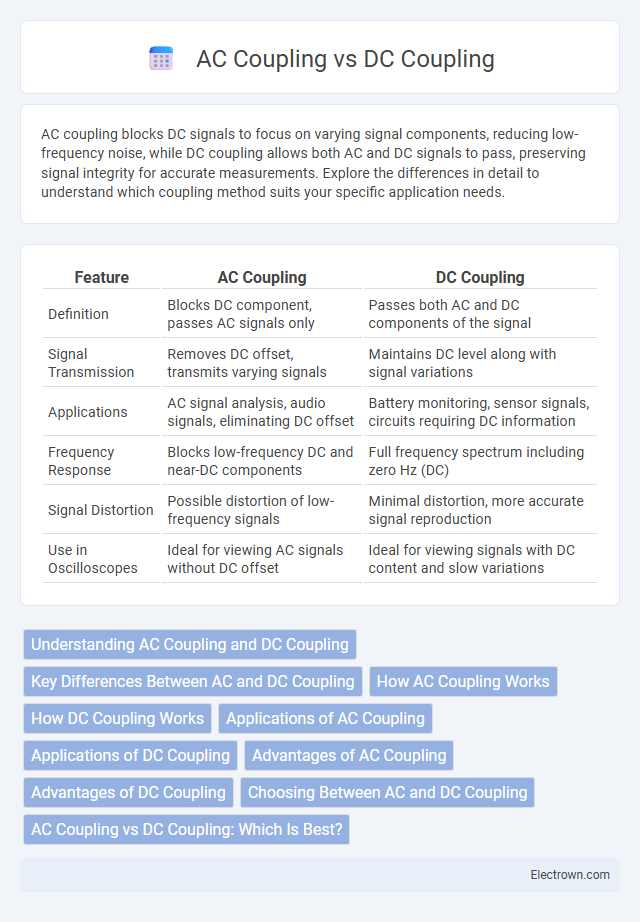AC coupling blocks DC signals to focus on varying signal components, reducing low-frequency noise, while DC coupling allows both AC and DC signals to pass, preserving signal integrity for accurate measurements. Explore the differences in detail to understand which coupling method suits your specific application needs.
Table of Comparison
| Feature | AC Coupling | DC Coupling |
|---|---|---|
| Definition | Blocks DC component, passes AC signals only | Passes both AC and DC components of the signal |
| Signal Transmission | Removes DC offset, transmits varying signals | Maintains DC level along with signal variations |
| Applications | AC signal analysis, audio signals, eliminating DC offset | Battery monitoring, sensor signals, circuits requiring DC information |
| Frequency Response | Blocks low-frequency DC and near-DC components | Full frequency spectrum including zero Hz (DC) |
| Signal Distortion | Possible distortion of low-frequency signals | Minimal distortion, more accurate signal reproduction |
| Use in Oscilloscopes | Ideal for viewing AC signals without DC offset | Ideal for viewing signals with DC content and slow variations |
Understanding AC Coupling and DC Coupling
AC coupling blocks the DC component of a signal, allowing only alternating current (AC) variations to pass through, which is essential in applications like audio electronics and signal processing where isolation from DC offset is needed. DC coupling, on the other hand, transmits both AC and DC components, preserving the entire signal waveform, making it ideal for applications requiring accurate measurement of voltage levels such as in oscilloscope inputs and sensor readings. Understanding the differences between AC and DC coupling is crucial for selecting the appropriate method based on the nature of the signal and the desired outcome in electronic circuit design and testing.
Key Differences Between AC and DC Coupling
AC coupling blocks the DC component of a signal, allowing only the alternating current (AC) to pass, which is ideal for isolating small AC signals from large DC offsets. DC coupling transmits both AC and DC components, preserving the full signal waveform and enabling accurate measurement of voltage levels and slow-changing signals. Your choice between AC and DC coupling depends on whether you need to analyze the signal's amplitude variations or its absolute voltage values.
How AC Coupling Works
AC coupling works by allowing only the alternating current (AC) signals to pass through while blocking direct current (DC) components using a capacitor in series. This capacitor removes any steady DC offset, enabling accurate measurement of signal variations around zero volts without distortion from DC bias. Your oscilloscope or signal analyzer typically uses AC coupling to isolate small AC waveforms superimposed on a DC level, improving the clarity of transient or noise signals.
How DC Coupling Works
DC coupling allows the direct transmission of both alternating current (AC) and direct current (DC) signals by connecting the input or output of a device without any blocking components such as capacitors. This method preserves the true waveform and voltage levels, enabling accurate measurement and analysis of low-frequency or steady-state signals. It is essential in applications requiring precise DC offset detection or where signal integrity over a wide frequency range is critical.
Applications of AC Coupling
AC coupling is widely used in applications requiring the elimination of DC offset to accurately measure or analyze varying signal components, such as in audio signal processing, oscilloscopes, and communication systems. It enables the detection of small AC signals superimposed on large DC voltages by blocking steady-state DC levels, making it essential for RF signal analysis and biomedical instrumentation like EEG and ECG monitoring. These applications benefit from AC coupling's ability to isolate the dynamic behavior of signals without distortion from baseline drift or DC bias.
Applications of DC Coupling
DC coupling is essential in applications requiring accurate measurement of both AC and DC components, such as sensor signal acquisition, power supply monitoring, and low-frequency waveform analysis. Your instrumentation benefits from DC coupling when capturing slow-changing signals or offset voltages that AC coupling would block. This makes DC coupling crucial in control systems, electrochemical analysis, and data acquisition for embedded systems.
Advantages of AC Coupling
AC coupling offers the advantage of blocking direct current (DC) components, allowing measurement of small AC signals without interference from DC offset. It enhances signal integrity in oscilloscopes and audio equipment by removing low-frequency noise and drift. This filtering capability enables accurate analysis of waveform variations and transient signals in electronics testing.
Advantages of DC Coupling
DC coupling offers the advantage of accurately measuring both AC and DC components of signals without distortion or loss of low-frequency information. This makes it ideal for applications requiring precise analysis of steady-state or slowly varying signals, such as sensor outputs and power supplies. Your measurements benefit from a true representation of the entire signal spectrum, enhancing diagnostic and monitoring capabilities.
Choosing Between AC and DC Coupling
Choosing between AC and DC coupling depends on the nature of the signal and measurement goals. AC coupling blocks DC components, making it ideal for analyzing small, time-varying signals superimposed on large DC offsets, while DC coupling preserves both AC and DC components, suitable for capturing the full waveform including steady-state voltage levels. Instrumentation such as oscilloscopes often provide switchable coupling modes to accommodate diverse testing scenarios in electronics and signal processing.
AC Coupling vs DC Coupling: Which Is Best?
AC coupling blocks DC components while allowing AC signals to pass, making it ideal for isolating signal variations without affecting the baseline voltage. DC coupling transmits both AC and DC signals, preserving the entire waveform for accurate measurement of low-frequency or static signals. Your choice between AC coupling vs DC coupling depends on whether you need to eliminate DC offset or capture the full signal, with DC coupling preferred for precision and AC coupling suited for noise reduction.
AC coupling vs DC coupling Infographic

 electrown.com
electrown.com